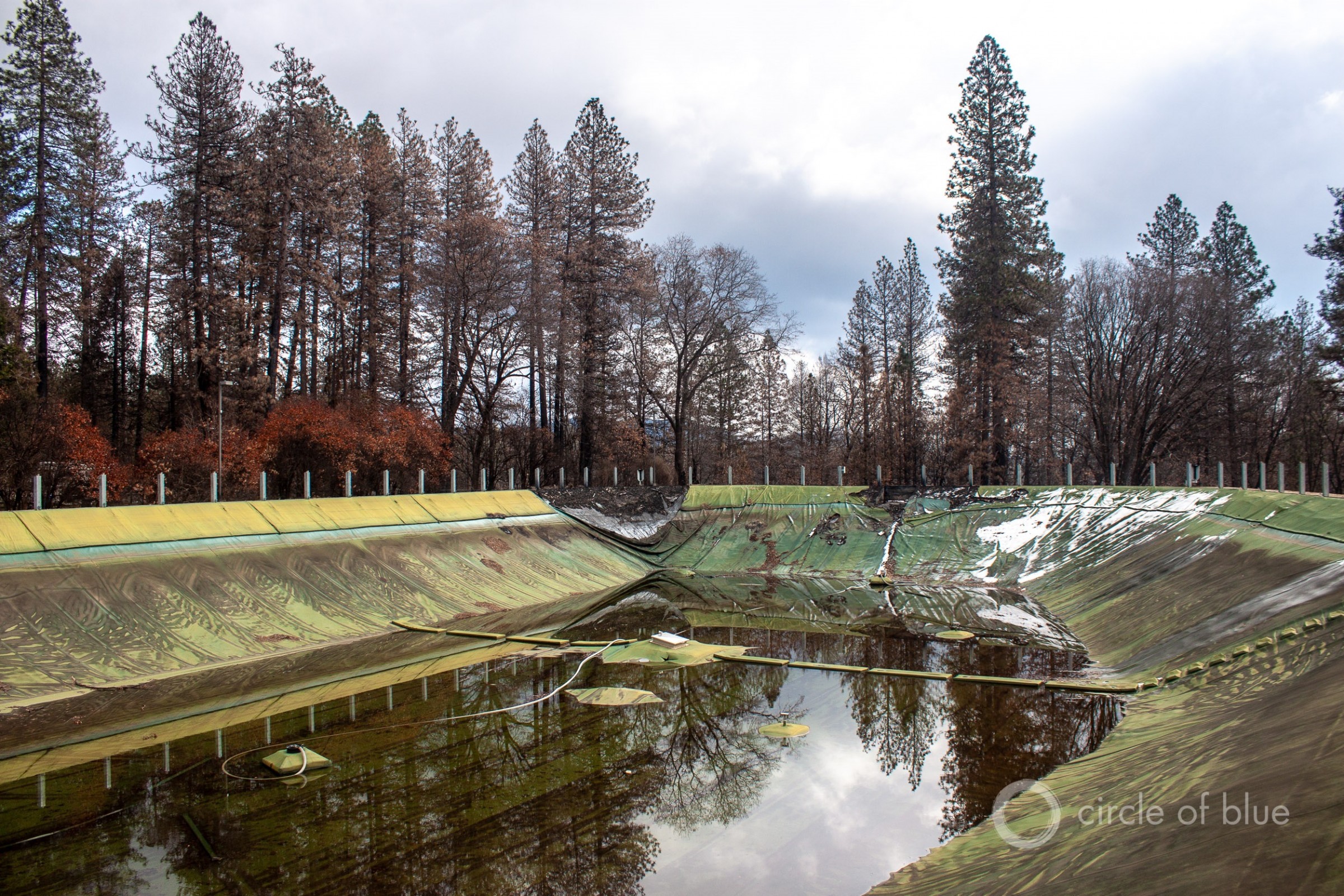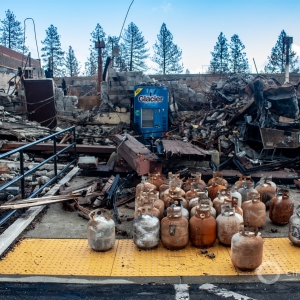Whelton leads a Purdue University research team that is advising the town’s water utility.

One of Paradise Irrigation District’s water storage tanks was damaged in the fire. It will have to be replaced. Photo © Brett Walton/Circle of Blue
By Brett Walton, Circle of Blue
After the Camp Fire burned more than 90 percent of the homes in Paradise last November, the town’s water utility was overwhelmed by the scale of the disaster.
Paradise Irrigation District turned to outside experts to help understand the extent of the damage to the town’s drinking water system, which includes contamination from benzene and other chemicals introduced during the fire.

Andrew Whelton, an environmental engineer at Purdue University
Andrew Whelton, an environmental engineer, leads a five-person research team from Purdue University that visited Paradise in early February.
Whelton has experience with large-scale water contamination events, having investigated the water system in Charleston, West Virginia, in 2014 following the spill of a coal processing chemical into the Elk River.
Circle of Blue’s Brett Walton spoke with Whelton about the challenges facing Paradise Irrigation District as the water utility tries to rid its system of contaminants. The following Q&A has been edited for length and clarity.
Paradise has a long road ahead, and the water system is at the center of it, as you know.
Well, it’s the backbone, right? If you don’t have water, you don’t have business, you don’t have safety, you don’t have normalcy. I agree.
How did you and Purdue University get involved?
I think it was January, Paradise Irrigation District (PID) contacted us and asked for advice on what they should be looking for and how they should be doing testing because they were simply overwhelmed by the scale of damage and they didn’t feel like some of the organizations involved had a handle on how to proceed on this type of damage assessment.
So we participated on the phone in January on conference calls, giving advice, sending materials about what to test for and how to do it. Then we started talking with the State Water Board about what they were doing. And then we got invited to California Office of Emergency Services (CalOES) calls where multiple agencies would report what they were doing and what their assumptions were.
On those calls we were invited but very quickly we interjected ourselves because sometimes assumptions would come up and they would go unanswered. But we knew there was evidence that that wasn’t true.
Assumptions about what?
We have looked at these chemicals moving into and out of plastic pipes and how long it takes to decontaminate them, and it takes a long time.”
Assumptions about what’s in the water. We knew that there would be a multitude of chemicals in there. And simply only looking for benzene would be inappropriate. As soon as we got involved we started telling them to look for others things. PID did that, they started looking for other things and they found them. They did volatile organic chemical (VOC) testing and then we started talking to the state and telling them they need to start looking for more than VOCs. When you have contamination you need to cast a wide net and you rule things out. You look for metals, you look for semi-volatile organic compounds, you look for VOCs, and then you look on the chromatogram, the print outs from the water test you run, because when you run a standard test, like a VOC test, the laboratory only tells you certain things about it. They don’t tell you everything that’s in the water. When you have these large-scale contamination events you can have unusual chemicals show up.
What makes an unusual event?
When you test drinking water there’s generally standard methods you apply and the same chemicals you look for over and over. Not all of them, but just some of them. That’s standard. The water board, state agencies, they look for the certain chemicals over and over. They look for trihalomethanes (chemicals used as solvents), they look for other things that are regulated. But when you have large-scale damage or contamination, like in the West Virginia chemical spill, if you were to look for standard chemicals you would find nothing.
People are trained only to look for standard chemicals, and they would have to conclude using that information that there’s no health risk. But in fact, non-standard chemicals, like the coal washing chemical in West Virginia did pose an acute health risk to the population. So they had to use non-standard methods to find these non-standards chemicals that did in fact pose a health risk. And that’s what we recommended for the Camp Fire response because when we initially got involved, many of the organizations were only looking for things that were standard because that’s what they’re most comfortable doing. Nobody really trains for how to investigate large-scale contamination events. And the people it happens to learn a whole lot, but that information and training doesn’t get passed state to state and utility to utility.
For the non-standard, non-regulated chemicals that could be in the water are there toxicity studies to understand acute or chronic health risks?
In the wake of the West Virginia study, my colleagues and I had enough. There was a lot learned in West Virginia. We can’t let every community in the country basically just start all over again every time something happens to them. We did a case study looking at what went right and what went wrong. We came up with a stepwise process for operations people, basically, for how to investigate things.
First thing you do is rapid testing to figure out what’s in the water. Once you figure out what’s in the water, you go to the health officials, the risk assessment people who know if there are toxicity studies available. When they tell you what’s safe for exposure, then you go back and determine how to get that bad water out of the system without harming people. And what you should be testing for. And after that, you test again to determine if you got it out of your system.
This is a process they should be following in California.
And are they?
Initially they — they being the entire response — initially they were not necessarily looking for all the chemicals in the water, which is what happens in community after community after community. And by expanding the way that they operated and looking at non-standard chemicals, they were able to rule things out. And tailor what they were looking for to what we know is present. So they’re at a point now where they’ve stabilized their testing method and they’re trying to determine how much of these 12 or 15 chemicals that we know of are in the water, what the scale of these chemicals are in the system. Then what they’ll do is target hot areas of the system, whether it’s water mains, hydrants, the service lines, meters, and from there they’ll make decisions about whether or not they remove and replace the asset or decontaminate in place.
The benzene and VOCs, where did they come from?
Several theories have been passed around. We haven’t found any conclusive evidence that the VOCs detected above safe limits in drinking water came from plastic pipes only or plastic pipes at all. We haven’t found any evidence that they came from the gaskets of these pipes, because that was a theory that was floated out there. We haven’t found any evidence that during the depressurization — when the utility lost pressure, large parts of their system basically had no water in it and were sucking air — that burned material got sucked into the system. That’s another theory. And that burned material then leached out these chemicals. I’ve heard another theory that the smoke in the air got sucked into the pipes. But the fact of the matter is there’s no evidence that any of these occurred. While they are possible to have occurred, there’s no evidence that one dominated over another. And it’s possible that different parts of the system, different types of phenomenon might have happened, which resulted in different loadings of these chemicals in the water system.
There is information that does indicate that some of the plastics were pyrolyzed. Pyrolysis is the thermal decomposition of organic material. So if you think of a spaghetti noodle, that’s like a polymer chain and that’s made up of a whole bunch of carbon atoms. If you take a knife and start chopping up the spaghetti noodle you start getting smaller molecules, like benzene, naphthalene, and other things instead of that long polymer chain. The theory is that pyrolysis caused plastics like gaskets and pipes to fall apart like spaghetti chopped up with a knife.
One of the complicating factors, too, is: say if a portion of the water system experienced fire damage and pyrolysis did happen. They had water sloshing around their buried pipes for quite some time and they still do because they had many, many leaks. So those chemicals in the contaminated water were moving from part of the system to part of the system which may also have caused contamination where these chemicals diffused into the plastics in a new part of the system and now are diffusing out over time. It’s really complicated.
Paradise Irrigation District people said that so far there is no pattern to the contamination.
Right now they only have like 200 samples, and they’re going to need 30,000 to 50,000 probably for their system because of the scale of the damage.
If PID expects 50,000 water samples and they have only 200 right now. Let me do the math real quick. They have less than a half of a percent of the water samples they need. And most of their samples are not spread out, they’re clustered.
They likely haven’t captured the variability in their system yet. The highest sample so far is probably not the highest in their system. They have less than 0.5 percent of the water samples they’ll need.
How would you describe the magnitude of the challenge that PID has before it?
It will probably resemble a military operation. The logistical coordination of what they’re facing will be significant.”
In comparison to West Virginia: following that spill many of those chemicals did not hang around inside the distribution system or plumbing. They were organic chemicals but they did not hang around. And the utility just kept flushing the system. In PID’s situation, when the fire came through, they had to run. It was chasing them. They were not able to stay in treatment plant and methodically make decisions about where the water was going and fixing leaks. In West Virginia, where 300,000 people were affected, the utility workers were operating in their buildings. In the Camp Fire, they had to run. The differences in responses likely resulted in differences in the scale of contamination. The chemicals in the water in the PID water system, and likely other water systems there, they hand around a lot longer. They really like plastics. We have tested benzene, ethylene, naphthalene. We have looked at these chemicals moving into and out of plastic pipes and how long it takes to decontaminate them, and it takes a long time.
So you have one thing with water loss, which is leaks and breaks, which is common to many disasters, like earthquakes. But you also have this fire damage where there’s wider-scale chemical contamination of 173 miles of mixed plastic/metal distribution system. And the chemicals like to be there, they like to hang around. So removing them is going to take a very long time, unless they identify a level of contamination that is unacceptable and they remove and replace that asset.
So years, we’re talking about?
As far as testing — just to do the testing — it’s going to take many months. I hesitate to say how many because it all depends on how many people they bring in to physically take water samples. They need to be doing at least 1,000 samples a month if not double that or triple. At the same time — and they know this — they need to coordinate shutting off water and isolating pipes. If they find a bad section, they need to dig it up and replace it. All while these other actions are happening. It will probably resemble a military operation. The logistical coordination of what they’re facing will be significant.
And Paradise Irrigation District has little money to work with.
Right. Right now they have very little money. One of the striking things for us was how lean their staff was and the magnitude of the damage and the effort ahead of them. We recommended they hire an in-house testing expert, hire an external consultant to help them manage the logistics and coordination. We made that clear to CalOES and FEMA that this isn’t going to be an April 1 deadline. It’s going to take years. The more support they give PID now, the faster things will recover.
And the other complicating factor is people wanting to move back, right? And if they want to draw from the mains how does that complicate the isolation and testing?
This is how I liken it. When someone is in an accident and needs to go to the hospital and needs to have an operation, they go on the operating table. We put this person on the operating table and all these experts come in. And they start looking the person over, looking at the vital signs. Are their arms OK? Is their brain OK? Are they breathing? Is their circulatory system OK? And we don’t let them walk away while we’re doing these evaluations. We isolate them. We say you cannot do anything else because you’re in such critical condition that we need to look at you. Now, at some time the doctors may say, it looks like everything is OK, we’ll let you off the table or we’ll let you out of the hospital.
The PID water system was extensively damaged. And the way it should be done is that the system should be identified and repaired, and then people should come back. But what’s happened is that people are already coming back and demanding to come back, and politicians are allowing them. I’m not saying that’s right or wrong, but that would like someone on the operating table saying, you know what, I’ve just got to do this one errand. You can come with me and look at my blood pressure, but you really need to walk with me while I’m going over here. I really need you to drive home with me, you can sit in the car, but I have to do this errand.
That exam is going to take a lot longer because you have all these other needs that this person, this system is projecting energy to. You also run the risk of damaging the system more. When somebody gets hurt and you tell them to stay off their foot or knee for two weeks, if that person gets up and starts running around, that’s a problem. And that’s the same analogy that would apply to the state of their system. Their system is sensitive right now, it’s extensively damaged, and they’re trying to do the best they can to investigate what’s wrong with it, to isolate parts of it, to replace parts of it, but they’re also being torn because individuals are demanding things from the system. I’m not saying it’s wrong to allow people to come back and be on the system, but I’m saying there are consequences associated with the limited manpower that exists at PID and their ability to handle all things all the time.
Brett writes about agriculture, energy, infrastructure, and the politics and economics of water in the United States. He also writes the Federal Water Tap, Circle of Blue’s weekly digest of U.S. government water news. He is the winner of two Society of Environmental Journalists reporting awards, one of the top honors in American environmental journalism: first place for explanatory reporting for a series on septic system pollution in the United States(2016) and third place for beat reporting in a small market (2014). He received the Sierra Club’s Distinguished Service Award in 2018. Brett lives in Seattle, where he hikes the mountains and bakes pies. Contact Brett Walton





